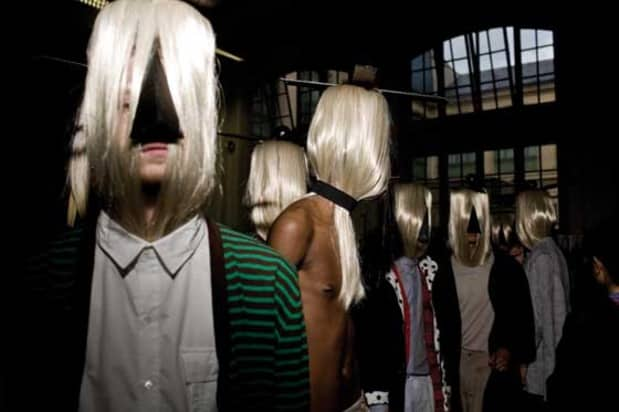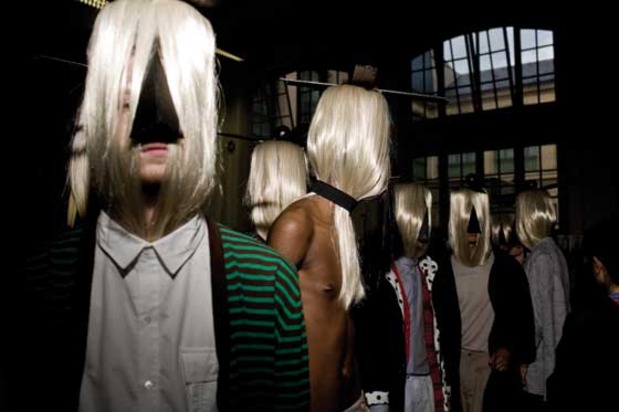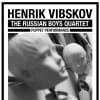Try plotting a straight line through the glorious la-la-land that is Henrik Vibskov’s imagination and you might run in to some obstacles. Regular fashion speak—that clunky system of trend reports and fancy biannual presentations—won’t help much with the navigation, especially since Vibskov doesn’t do fashion in the traditional sense. Pants, dresses and shirts are the building blocks of his work, but when the Danish designer sits down at the drawing board each season, he isn’t designing clothes as much as creating a living, breathing parallel universe. Going to a Vibskov show can feel like you’ve fallen through a rip in the fabric of time, or cracked the closet door on a weird, sartorially-enhanced Narnia. His spring 2007 event, for example, featured models in camouflage jackets, printed leggings and colorful three-piece suits sprawled out on a minefield of plastic breasts on stalks, which Vibskov dubbed the Big Wet Shiny Boobies collection. Earlier this spring, in a cavernous warehouse on the outskirts of Copenhagen, he presented his fall 2009 line, the Human Laundry collection, with a web of humongous hamster wheels powered by an army of models in oversized Amish hats. One review cited Roald Dahl’s Charlie and the Chocolate Factory, and in many ways, Vibskov shares the Norwegian-British author’s magic—a cheeky, childlike ease with the fantastical and the madcap.
When we talked to Vibskov, he was coming off the high of showing The Solar Donkey Experiment, his spring 2010 collection, at men’s fashion week in Paris. Speaking from the courtyard of his studio in Copenhagen, he is already on to the next project, putting the finishing touches on costumes for the Roskilde music festival, where he’s to perform alongside Danish electronic musician Trentemøller. The set design for the show, which includes 30 dancers and an elaborate dragon formation, is entirely his creation, though Vibskov won’t be part of the troupe come show time—he’ll be safely tucked behind his beloved drum kit. Not that the Dane is shy about getting in on the act: The Fringe Projects, an art series he put together with Andreas Emenius, a fellow graduate of London’s prestigious art school Central Saint Martins, is peppered with wacky self-portraits of Vibskov in head-to-toe Cousin It-like outfits and skintight neon bodysuits.
Though his passion for music predates the fashion side of his brain, Vibskov isn’t one for splitting creative hairs—each of his talents invariably feeds the other. Walk into his store in Copenhagen, with its brightly patterned walls, Pac-Man knit laptop cases and Vibskov-designed strollers favored by the likes of new mom MIA, and you get the feeling he molds his entire world out of one giant lump of multi-colored Play-Doh. It’s that sense of fun and naïveté that has carried the designer from the hallways of Saint Martins towards the gleaming registered trademark of a globally recognized brand in just under 10 years. He’s a doer as much as he is a thinker, and when he answers the phone for this interview, he is mid-multitask, as usual. “I’m busy tour guiding the team,” he says (“tour guiding” being a friendly euphemism for bossing people around). He’s only allotted 20 minutes for our interview in his tight schedule, but we end up jabbering well into the afternoon like new friends at the playground.
What kind of music did you listen to growing up?
All sorts. Of course, I started out with Jimi Hendrix and Neil Young and that
hippie era. And then I went a little darker and started listening to Depeche Mode. I actually got really in to the British indie rock scene, which was also about having the right look, the right haircut, the right attitude. And I think the idea of attitude coupled with style really feeds in to what I do now. Not that my stuff looks rock & roll
or anything—but it is about creating an identity, and much of that comes from music.
Weren’t you in a band before you went to fashion school in London?
Yes, it was called Luksus, which is Danish for “luxury.” We played
a lot of indie stuff, a bit like The Smiths. I moved to Copenhagen
to be with the band, but I figured I needed to do more than just
hang out. Around that time I met this really hot girl who was applying to Central Saint Martins. I wasn’t completely sure what the school was all about, but I’d heard of the place. I thought maybe it had something to do with the first Sex Pistols concert or maybe something with Jarvis Cocker. I remember thinking maybe Sade went there. I put together a portfolio, bought a ticket, went to London for
the first time, did the interview for the menswear course and got in.
Did you get the girl?
Yes I did.
When did you realize you were at one of the most famous fashion schools in the world?
I think I realized it the first day. It was totally like a catwalk show. All the new students were a bit nervous, and everyone was so dressed up. I’ve actually just been over there teaching, running a two-month project. We had 50 students, and
I blindfolded them all in the beginning. They had to sort out some of their personal memories, and by using different smells and sounds,
I got them thinking about the scariest or happiest moments in their lives or some other experience that had nothing to do with fashion. When you’re very young and trying to be creative, you tend to be focused on what’s going on around you. You look at all the magazines and end up doing the same as what’s already out there. So this was about starting somewhere else—trying to make it more personal, instead of, Hey, I saw this red dress in i-D magazine and I’m just going to copy it. I really enjoy the teaching. It’s like being a tour guide out in the jungle.
Do you think of yourself as a fashion person?
I really don’t think of myself as a fashion person and maybe that’s the problem. I just feel pretty normal. I know I do fashion, but I try to fight it because there’s this stigma about being a designer, like you’re a little bit stupid and a little bit over the top—even if you’re educated and you have work in a reputable design museum or an art gallery. Particularly here up north where we don’t have any history of fashion.
There are so many fashion designers coming out of Scandinavia right now though. How do you feel about the scene?
Sometimes I think we play it too safe. I recently went to Paris, to one of the tradeshows, and it was full of Scandinavian brands. They’re all doing the same plaid shirts, German trousers, blah blah blah. I got a little pissed off actually—and I know some of them probably think my stuff is too colorful or whatever—so I went to one of them and asked what fashion school they’d been to. Turns out they hadn’t been to fashion school at all—they were graphic design dudes. I asked them who did their patterns, and they were really vague. You know, it’s not that you have to go to school, but sometimes it’s good to have a foundation in a
few things. The style of everything there just looked totally, totally the same. And maybe that’s real fashion—I don’t know. It made me wonder if maybe it’s me, maybe I’m just totally on the wrong track. At the moment it’s all very classic with lots of refined shirts and trousers. I love that myself, but when there are 40 brands doing the same trousers—everything’s tailored, but nobody really has any tailoring expertise—I get bored with it, so I had to go and say something.
Why do you keep Copenhagen as your base and not one of the bigger fashion epicenters, like Paris or London?
Copenhagen is very chill, you know? And very cozy and that’s a big part of it. I think sometimes
it’s really good to be a little outside the main cities. For example, the other day I was working on my perfume, which comes out in the fall. There are three big perfume companies in the world, and I’m working with one of them in Paris, the same people that make the Commes Des Garçons and Dior scents. So I was just sitting here in Copenhagen hanging out in the courtyard thinking about what we should call the fragrance, and Solar Donkey Power just seemed like the right fit. At first the perfume folks weren’t into it, and a few people in New York even said we shouldn’t call it that because donkey is slang for ass and it would be like calling the fragrance Ass Spray. But after a while they loved it.
What about your latest show, The Solar Donkey Experiment?
The overarching theme has a lot to do with analog communication. We used umbrellas because the communication aspect is more old school, like fire or smoke rings on top of a mountain. That’s the donkey part, the slowness, the analog. It almost looks like we’re trying to communicate with the rest of the world with some kind of mechanical mobile installation. The color combination has some elements of old ladies’ underwear in there too. That’s why you see all the red, the black and the fringing. I try to mesh everything into one universe, so I’m constantly trying to think of the bigger picture. For example, in Paris this season, we used some really dark ambient shit—Murcof, a Mexican musician, mixed in with some dark metal. I wanted something that would communicate directly with the audience to get a visceral reaction.
You seem to really enjoy the theatrical aspect of fashion shows.
Yes I do. It’s like building up a universe that people can experience for about 20 minutes. I like the energy of a show—it’s almost like going to church. The whole set-up is religious with people sitting and waiting—the runway in the middle and the applause.
You’ve been known to get up on the runway with your drum kit.
I have, but I try not to do that every time or it gets too much. My brothers and sisters gave me drums when I was 10 years old and I’ve been playing ever since. You know the Smurfs? We call them Smølferne in Danish. My first record was the Smurfs singing in Danish with some old guy. I was maybe five or six, and I used to play it on my portable record player. I still really love performing whenever I can. Recording is great, but there is something about creating a live experience people can take home with them. And that’s the good thing about music—you get instant feedback. Sometimes with fashion it’s slower even though both mediums make
a direct connection with the senses.
Looking back, which collection did you have the most fun with?
I think it’s my Pig collection. It was my final collection at Saint Martins in 2001 and it opened up a lot of things for me. I was at school, and I really wasn’t sure what to do. I told my teacher that I was going to go on tour. They all said I was crazy, that this is Saint Martins, it’s world famous, and that you can’t go on tour in the middle of your final collection. But I did it anyway, and I came home three weeks later having decided I was going to do something with all the symbolism and history of pigs—religion with pigs, Islam, food culture. I’m also from Jutland, the countryside in Denmark, where there are plenty of pigs and bacon. The models came out on to the runway holding bags that looked like pigs. It’s funny because going on tour actually helped open my mind. The Face interviewed me about the collection, and when we did the show it went mainstream with coverage in the Times, the Guardian, the British morning telly. Suddenly I was doing an exhibit in Tokyo and another in New York, and it just went full-on. It was pretty crazy. But that’s life. That was almost ten years ago now.
Did you idolize any designers while you were at Saint Martins?
Not really. I’ve never been that much into fan fashion stuff. Normally
I’m more into great pieces of art, anyway. I think about myself and
my influences in terms of a very organized square. In one corner there is color, so for example, brands like Comme des Garçons,
Paul Smith and a few artists all live in that section. Another corner is about creating stuff you can use, like Ikea and Levi’s—utilitarian design. Then the third corner is for the avant-garde, so it’s designers like Bernhard Wilhelm who make crazy, strange stuff which is not really usable. The last corner is more about classic tailoring—the technique, the pattern cutting, the third dimension, the discipline—the whole technical part that you find in places like Saville Row. I try to work in the middle of this square. Sometimes I go too far in one direction, or too far in another, but I want to have a bit of everything.



